What Is Organic Content?
Organic content is any content audiences find on their own that doesn’t rely on paid marketing techniques. Meaning you share it without paying for advertising space.
Here’s an example:
When someone goes to Google and types “best coffee grinder” into the search bar, the search results provide links related to coffee grinders.
The first group of results has the “Sponsored” tag. Which means those brands paid to appear on this results page. So, they aren’t organic results.
Below those ads are organic results. And those websites achieve high rankings (positions) using SEO best practices rather than paid tactics.
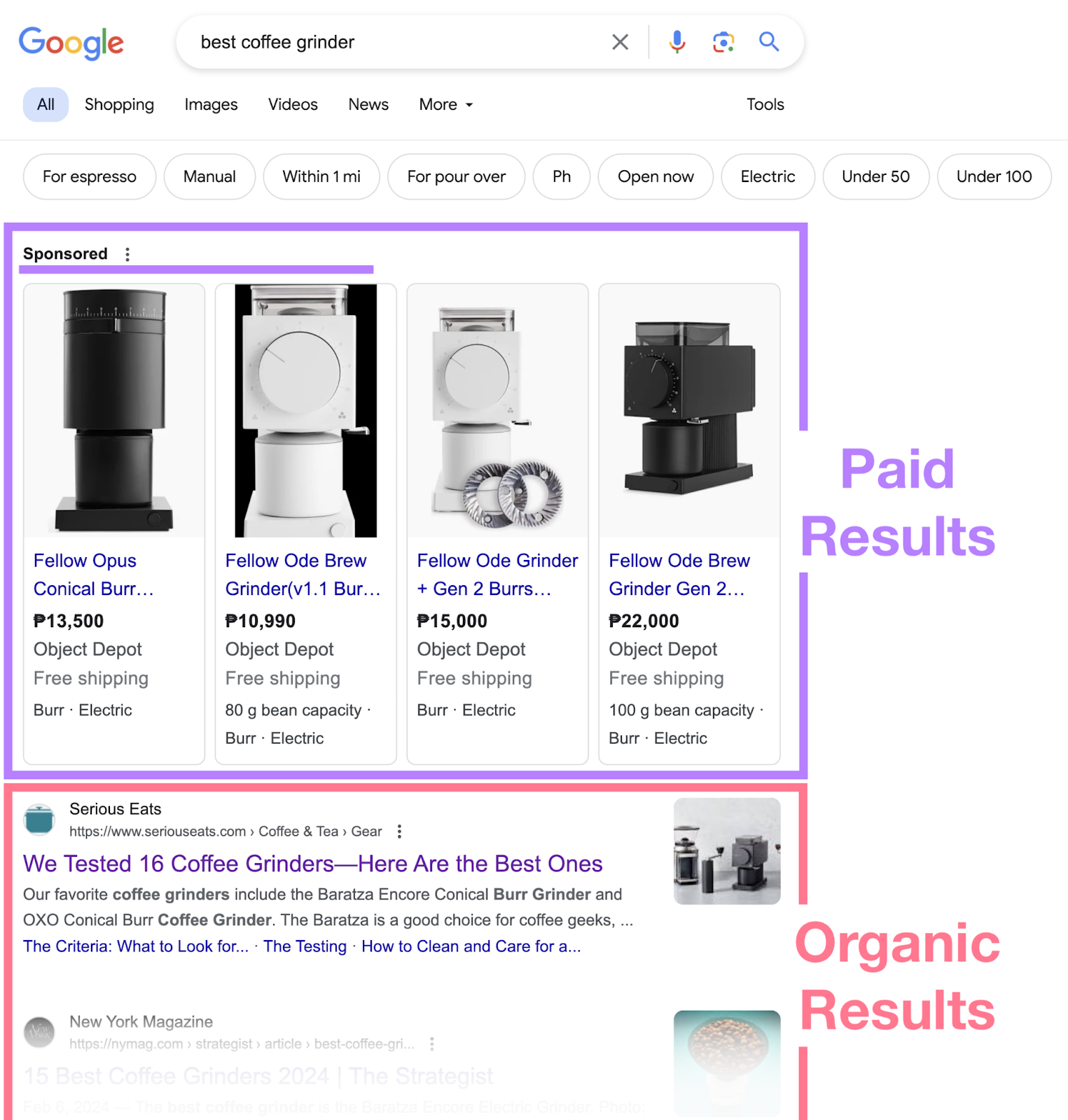
The first organic result in search engines usually gets a lot of traction.
In the example above, the top organic result gets 15.4K views per month, according to the Organic Research tool.

Marketers create organic content to increase their company’s visibility in search engines and on social media. To reach prospects, engage existing customers, and increase conversions.
Organic Content vs. Paid Content: What’s the Difference?
The key difference between organic and paid content is distribution: organic content uses free distribution channels, and paid content uses sponsorship or advertising.
Here are a few more differences between organic and paid content:
| Organic Content | Paid Content | |
| Goals | Educates your audience, improves your brand visibility and credibility, and encourages engagement | Increases brand awareness, finds new leads, and sells a product or service |
| Longevity | Reaches your audience for months or years | Reaches your audience only while the paid campaign is ongoing |
| Results | Takes longer (usually months) to achieve results | Results appear quickly—sometimes immediately |
Because paid content yields results more quickly, brands often use it to kick-start their marketing results. Or get sales quickly.
But organic content is an important piece of your marketing puzzle. We’ll discuss that more in the next section.
What Are the Benefits of Organic Content?
Brands invest in organic content for a variety of reasons.
Here are some of the main benefits:
It Increases Search Visibility
SEO organic content allows you to rank highly in search results—when it’s well-executed. Which increases your reach on search engines.
For example, once Pointe optimized their blog posts for organic keywords, their website started achieving a #3 average ranking for over 50 keywords. And the company saw leads increase by an average of 100 per week.
It’s Cost-Effective and Can Create Long-Lasting Results
A one-time investment in organic content created with search engines in mind can bring organic traffic for months or even years.
For example, Semrush’s guide to what SEO is has been generating thousands of monthly visits since June 2023. Which you can see in our Organic Research tool.

That said, content like articles should be periodically updated to ensure accuracy and relevancy over time. To deliver the most value to your readers.
It Improves Engagement
When users come across social media posts or articles they enjoy, they’re more likely to share them or interact with them. And those users may be more receptive to your brand in the future.
The following Instagram reel by chef Christina Soteriou was viewed over 1 million times and received over 48,000 likes.

The reel explains how to eat balanced meals on a vegan diet and includes snapshots of different meals. Plus, it provides an overview of how much space each food type should take up on your plate.
Aside from reinforcing relationships, this engagement can also expand your reach.
In the example below, an organic Instagram post published in February 2023 has been shared over 100 times.

Thanks to the high engagement, the post reached nearly 4,000 people who don’t follow this Instagram profile.
It Helps Establish Authority in Your Industry
Audiences trust brands with industry authority. And one way to build trust is to create high-quality organic content that showcases your expertise and credibility.
Jasper, a startup that launched an AI writing tool in 2021, has consistently used blog posts to establish authority in their niche. And draw attention to their product.
Their earliest blog posts offer writing advice. To establish themselves as a valuable resource and teaches readers how to use Jasper to improve workflows.

6 Types of Organic Content
Explore different types of organic content to understand what works best for your specific audience.
Here are six types to consider:
1. Blog Posts
A blog post is a type of organic content that offers insights, instructions, or opinions related to a specific topic. The typical length of a blog post is between 1,500 and 2,500 words.
For example, a home improvement brand might write an informational blog post about different types of wall paint. Or, they could publish a how-to guide that teaches readers how to care for their lawns.
Like this piece from Black & Decker:

To come up with blog post ideas, you can:
- Conduct keyword research (we’ll go over this in more detail later on)
- Read your competitors’ blogs
- Research your audience’s interests and pain points
2. Thought Leadership Content
Thought leadership is a broad category of organic content that involves an expert sharing their unique insights and wisdom. And is usually highly opinionated.
It can be in the form of a blog post, a quote image on social media, a video, or even an ebook. So, get creative with the format of your thought leadership content.
Consider this article published on Animalz that shares ideas on creating an effective content strategy based on the author’s first-hand experience.
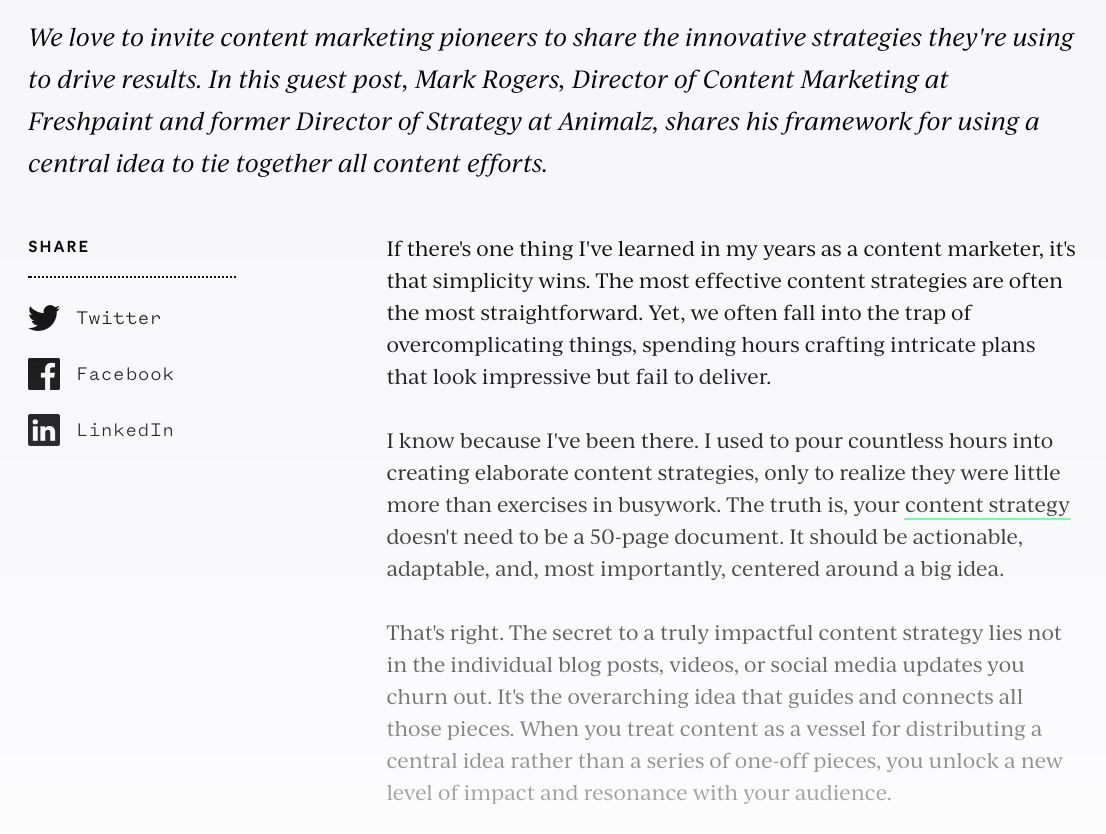
The majority of companies leverage their C-suite and senior management for thought leadership content. Because they possess the needed expertise to produce helpful, reliable insights.
But don’t let this be a limiting factor. Your company could have subject matter experts at all levels who are ready to share their thoughts.
3. User-Generated Content
User-generated content (UGC) is any promotional content your customers or other contributors create on their own—without being paid to. And you can then share that content on your own channels.
Here are a few examples of UGC you can encourage customers to create:
- Reviews on Google, Amazon, Tripadvisor, and other business listing sites
- Photos of the results they’ve achieved with your product or service that are shared on social media
- Recorded videos of how they use the product or service
UGC is easy to repurpose across different channels. You can add it to your email campaigns, website, or social media pages.
Here’s an example of how shoe retailer Trash Planet incorporates UGC into their abandoned cart email:

A key benefit of UGC is that it creates social proof to reassure potential customers of your brand’s credibility. Which could encourage them to make a purchase.
4. Social Media Posts
Organic posts on social media include visual, written, and audio content. Depending on the platform you’re using and your brand identity.
Skincare company Beauty by Earth uses videos and images to promote their products on Instagram:

But social media users are overwhelmed with content. So how do you find success on such competitive platforms?
Follow trends that are relevant to your audience. And take note of social media algorithm updates.
A few years ago, for example, Instagram began prioritizing video content. Which meant brands had to start posting more videos if they wanted to continue engaging their audiences.
As you build your social media presence, you can reach new audiences and educate them about your products or services. And send them further down the sales funnel.
5. Infographics
Infographics are images that present information using visual elements and text. Often to convey complex or abstract ideas in an easy-to-understand way.
You can also use them to grow your reach for free. Because readers easily share them across different platforms.
For example, this Semrush infographic was reposted almost 200 times on X (formerly known as Twitter).

Making your infographic as visually engaging and informative as possible is important if you want them to succeed.
Check out our list of 41 infographic examples for inspiration.
6. Videos
Videos let you present information in an engaging format that can incorporate audio, text, animation, etc. And they’re ideal for walking through processes or explaining concepts.
Here are a few examples of video content for your brand:
- Interviewing experts about topics your audience is interested in
- Recording customer testimonials or case studies
- Streaming live videos, such as Q&A sessions
- Demonstrating how to use your products or services
For example, this video teaches beginners how to do keyword research with a step-by-step tutorial.

With the growth of social media platforms like TikTok, video marketing has become even more important. Our State of Content Marketing report shows marketers rank videos as the best-performing content format.
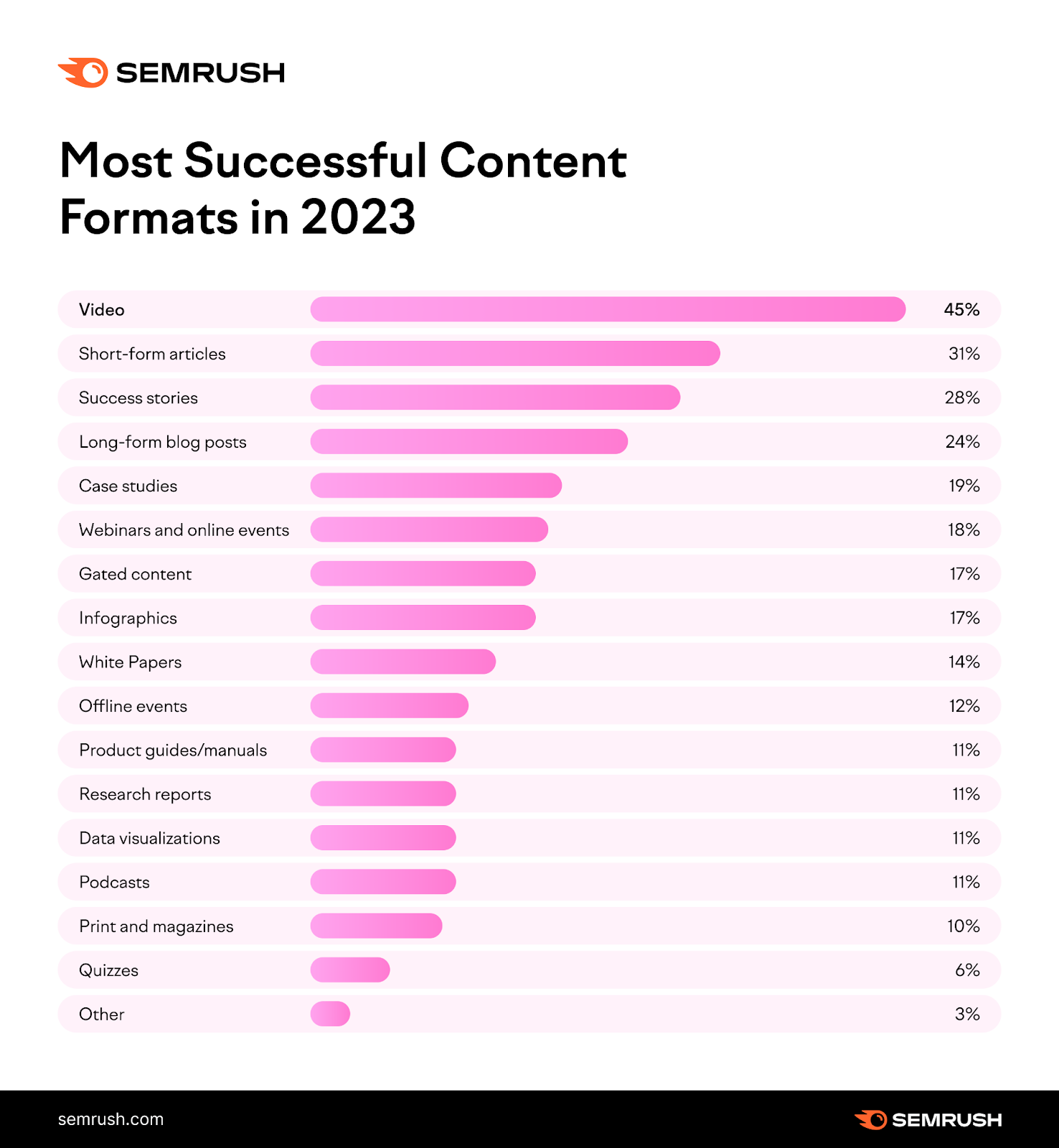
Best Practices for Creating Effective Organic Content
Follow the tips below for a successful start to organic content creation.
1. Conduct Keyword Research
Keyword research is the process of finding queries your target audience types into search engines. So you can find relevant topic ideas to optimize your content around.
To get started, use Semrush’s Keyword Magic Tool.
First, type in a keyword related to your brand. And click “Search.”

The tool will then return a list of different keywords related to your search.
Information about search intent (i.e., the motivation behind a search), monthly search volume, and keyword difficulty allow you to identify suitable opportunities.
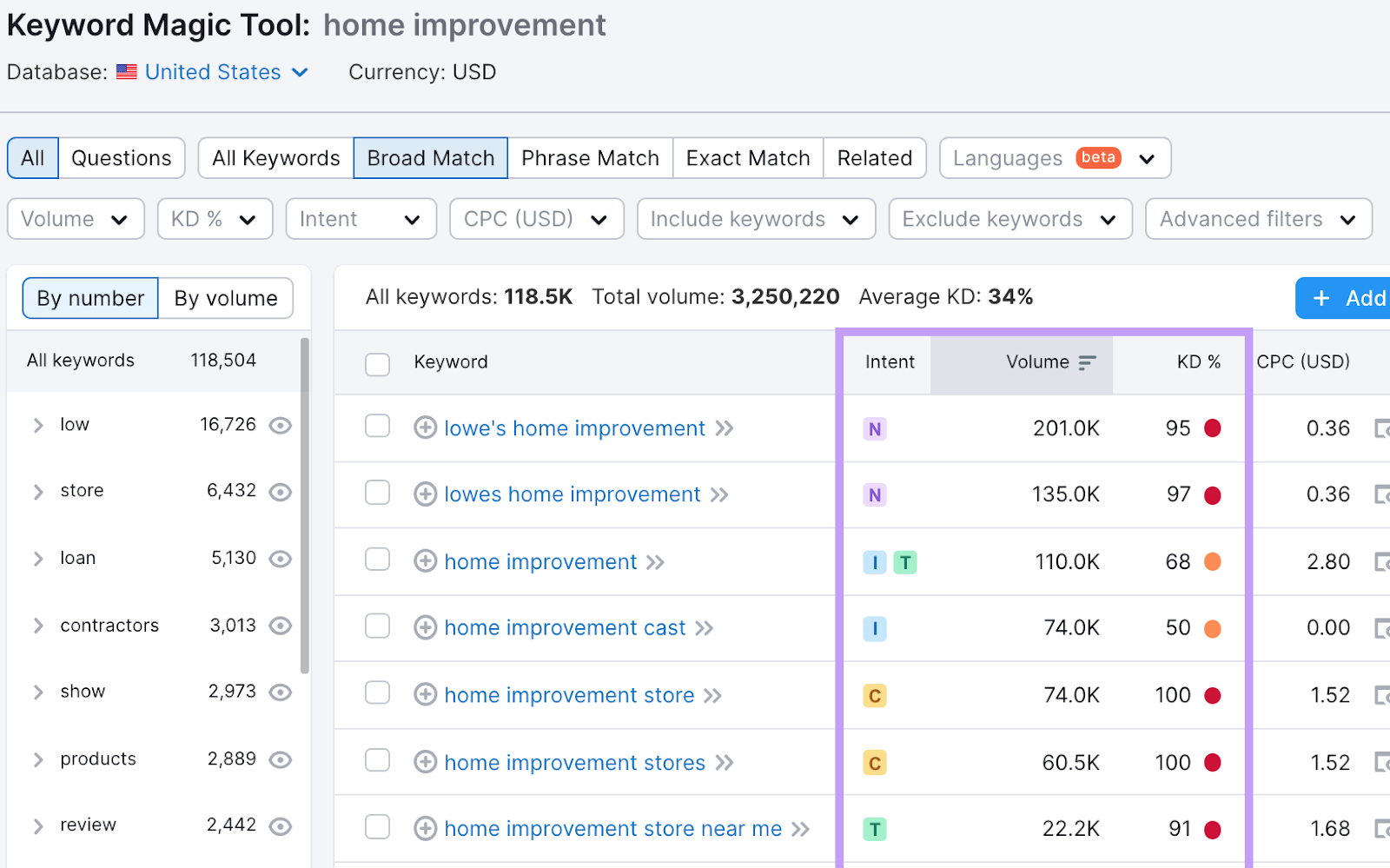
On the left-hand side, there’s a list of keyword clusters. Clicking on one will display only the keywords in that group.
Click on a specific keyword to learn more about it in Keyword Overview.
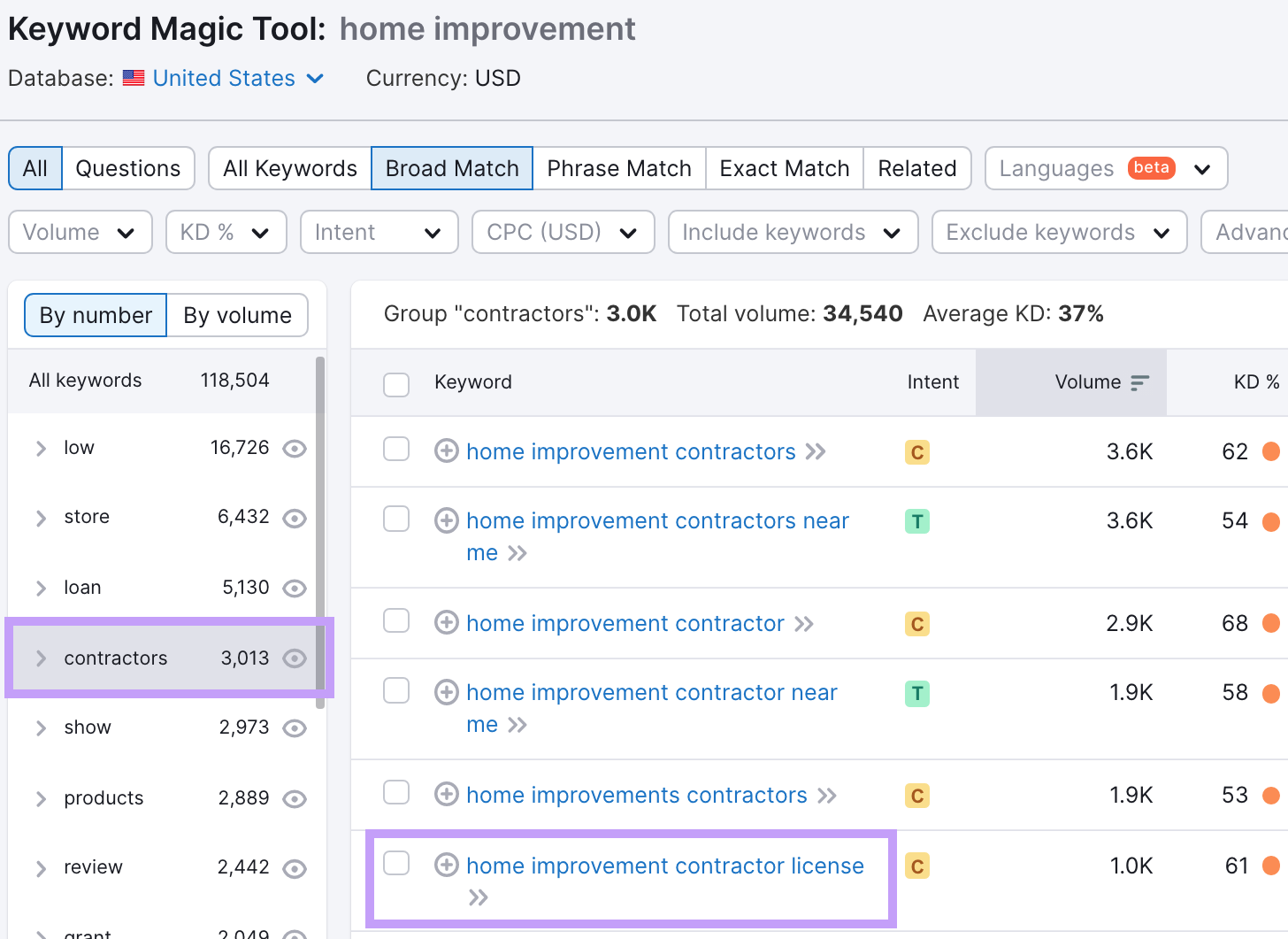
You’ll get information like a geographical breakdown of monthly searches. And search trends over the past 12 months.

Scroll down to the “Keyword ideas” section to find variations of your seed keyword. You might decide to incorporate some of them as secondary keywords into your content.
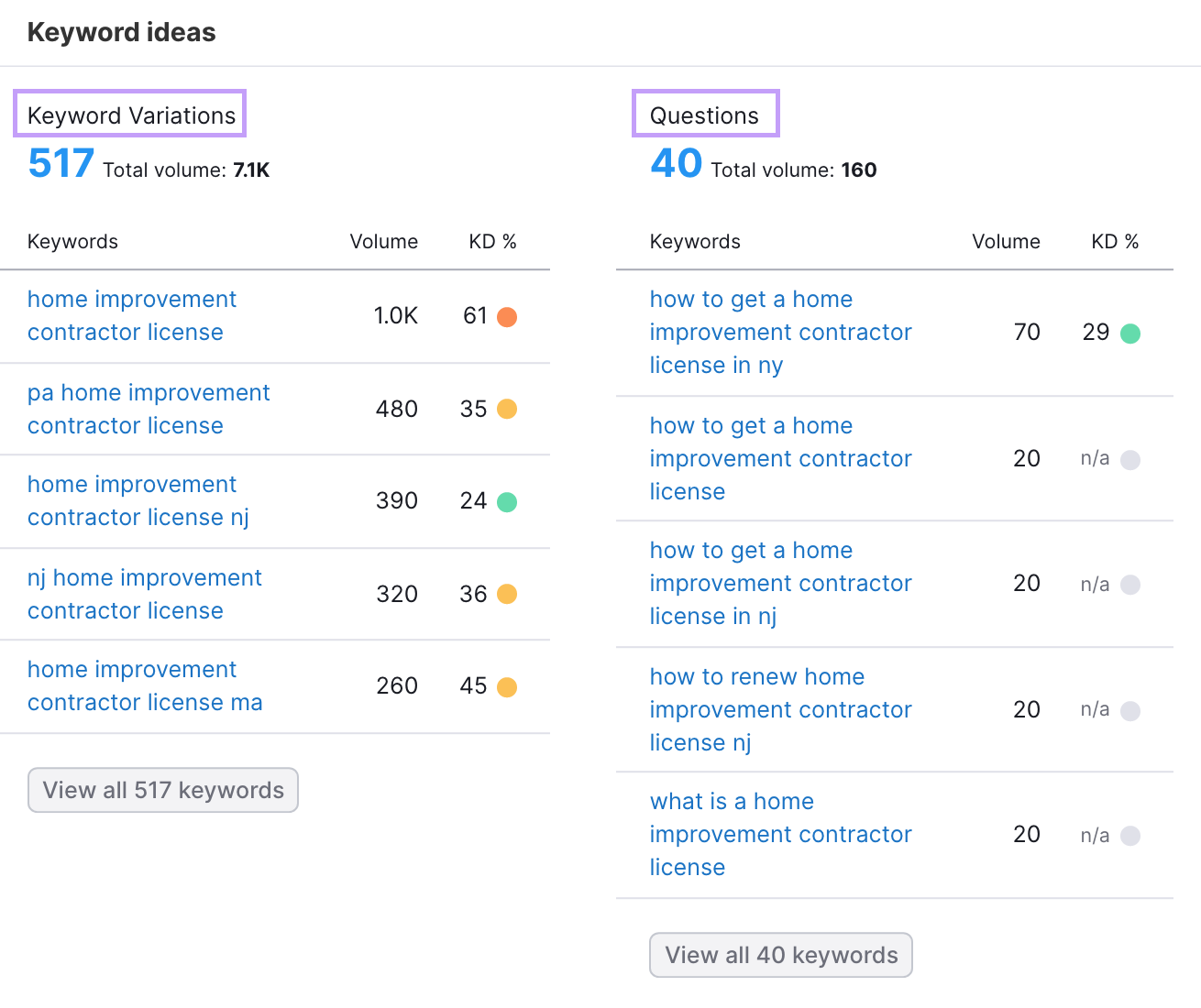
Scroll down to “SERP Analysis” to get an overview of the top-ranking websites. This gives additional insights into the organic content that shows up for your target keyword.
In this case, Google shows informational results from government websites.
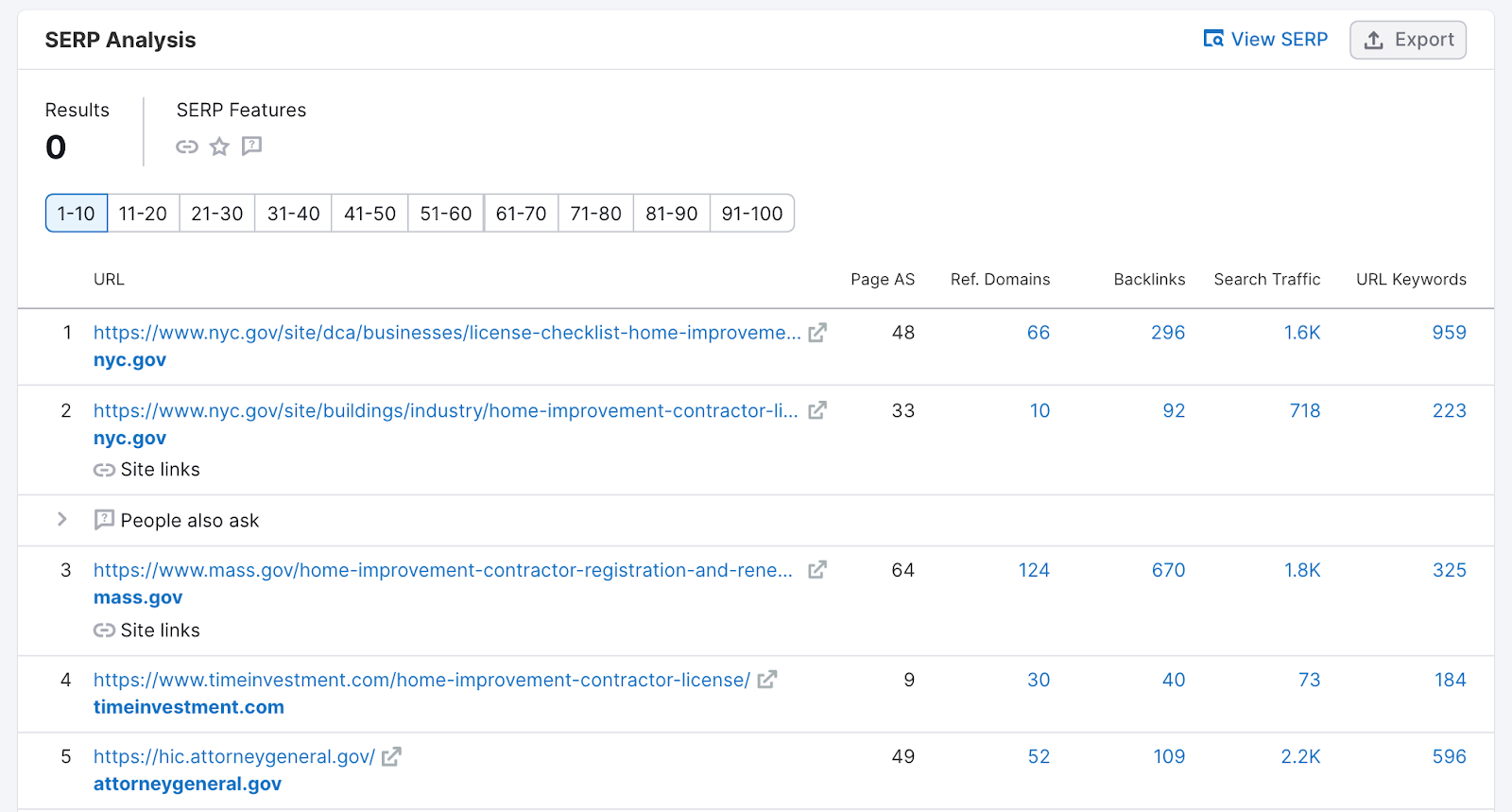
If you decide to target this keyword, the next step will be to analyze the top-ranking content by clicking through to it. And seeing how you can provide more value than the competition.
You can also get keyword ideas from your competitors using the Organic Research tool.
Enter a competitor’s domain into the search bar and click “Search.”

Click on the “Positions” tab to find all the keywords the website ranks for. These keywords could be great opportunities for you, so make note of the relevant ones.
Also, take note of the “SF” or SERP features column. Which tells you which SERP features show up on a keyword’s results page.
SERP features like a local map pack, AI Overview, People Also Ask block.
If your competitor is ranking well for a keyword with SERP feature you want to rank for, take note of that keyword, too.
Then, go to the “Pages” tab to see which pages generate the most traffic for your competitor. This information can be helpful for ideation.

It’s okay to cover the same topics as your competitors do.
But always ensure your content is original and offers something more—a unique point of view, expert insights, or simply information no one else has provided yet.
2. Understand Your Audience
When creating any type of organic content, keep your audience top of mind.
Why?
Because content that’s aligned with your audience's interests and pain points will engage them better.
Use a tool to research your audience and uncover insights for content personalization. Like the Audience Intelligence app
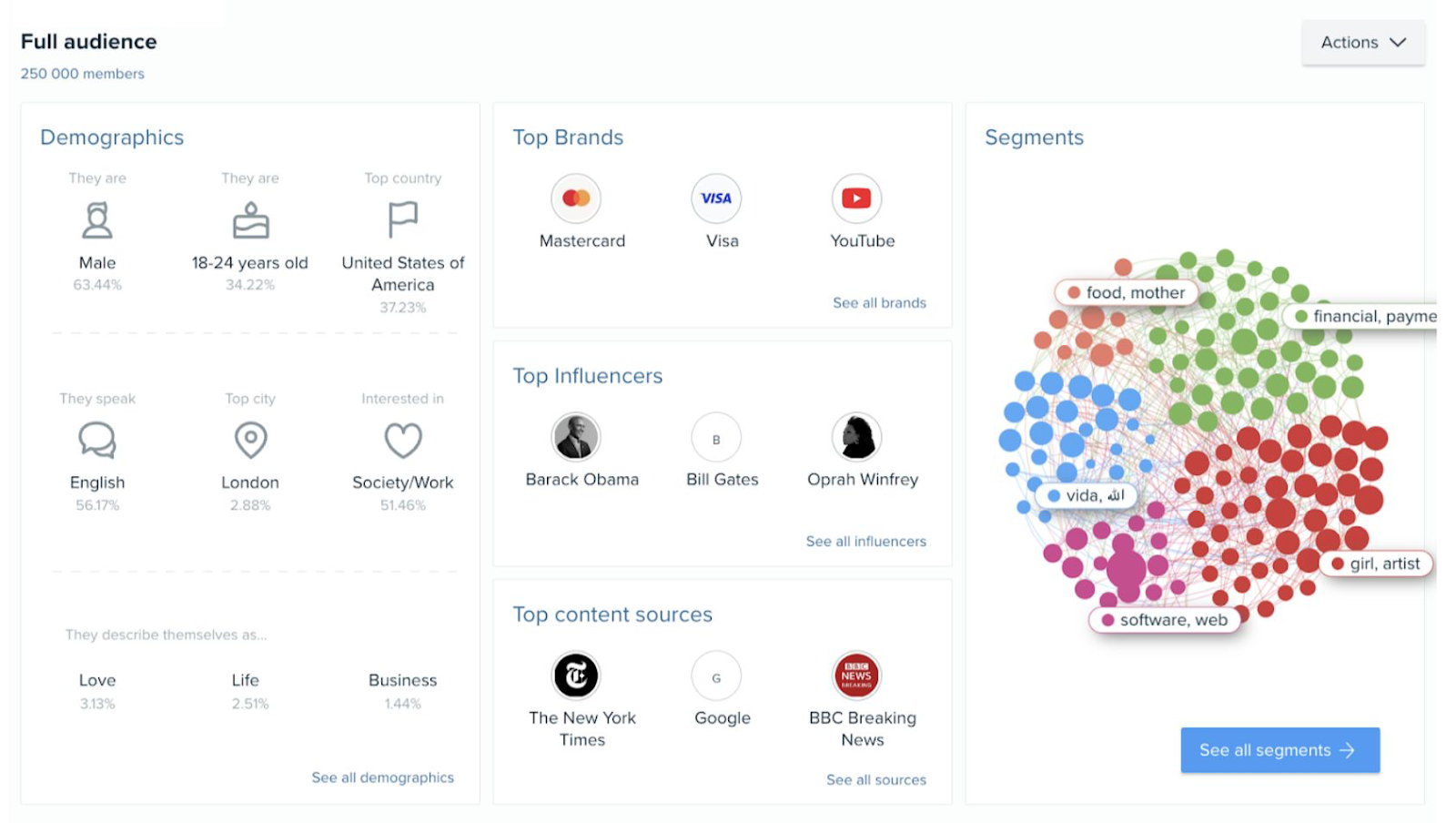
It uses data from multiple sources to deliver a comprehensive audience analysis. From their favorite influencers to how they engage with content.
The app also identifies the best online and offline channels to reach your target audience. To help make content distribution as effective as possible.
3. Craft High-Quality and Engaging Content
After conducting keyword research and analyzing your audience, the next step is to create high-quality content.
And quality content is:
- Comprehensive
- Accurate
- Relevant to your audience
Whether you’re making videos or writing ebooks, try to leverage subject matter experts when possible. And offer unique perspectives on the topics you’re covering.
This will help your content stand out, deliver value, and capture your audience.
And the content should serve your business goals. Such as bringing in more leads or growing your following.
When appropriate, sprinkle in a call to action and/or a product or service mention.
As you invest in quality, you’ll start drawing more attention to your brand—53% of marketers say making content more valuable has helped to boost their search rankings.
4. Optimize Content for Search Engines
Optimizing your content means making it easily discoverable to search engines. And helpful to humans.
Which means following SEO best practices for articles, such as:
- Incorporating the target keyword into the title tag (HTML that indicates a page title), subheadings, body text, URL slug (the end portion of the URL), and meta description (HTML that briefly summarizes what a page is about)
- Including keywords that are semantically related to the target keyword
- Adding images and videos to increase user engagement
- Adding relevant internal links to encourage users to explore your site and facilitate web crawling
Use ContentShake AI to draft search-optimized content. It generates outlines and different content sections like the introduction.
When you first open the tool, it will ask you questions about your business and role. To generate personalized content ideas.

After you complete the setup process, you’ll be taken to a dashboard with a list of ideas that were generated using your business information.
But you can also create your own using the “My own idea” button.
To start generating your article, click “Start writing” beside your chosen idea.

Next, customize the article parameters, such as tone of voice and word count. Click on “Create article” when you’re done.

The tool will generate an article for you. Complete with optimized body text, headers, and images.
Review the results and make adjustments. Before publishing the article on your website.
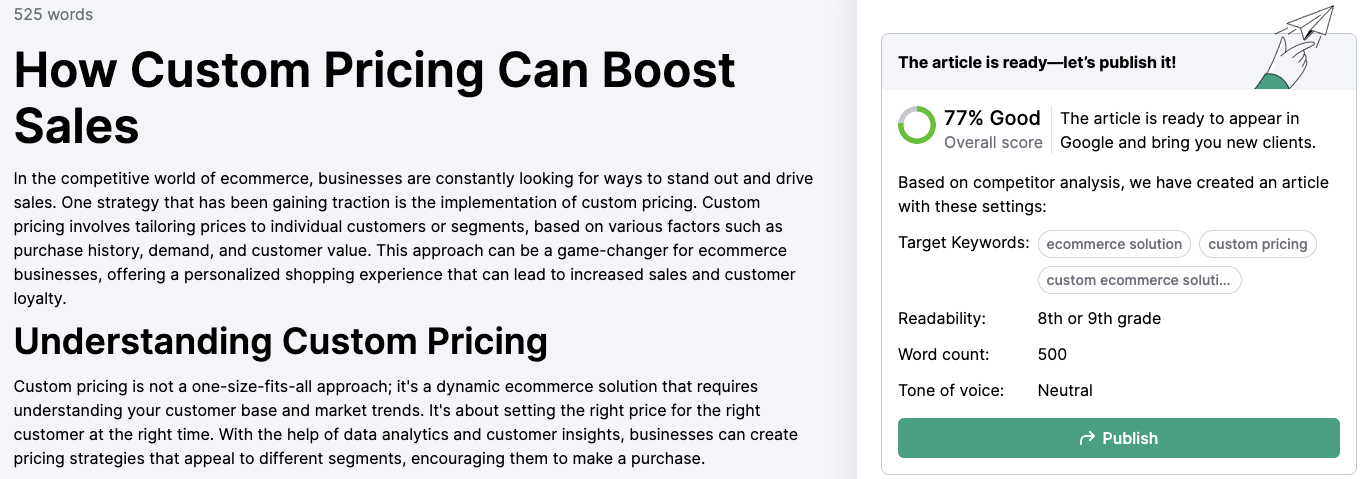
Here are some other content optimization tips:
- Pay attention to video SEO. Use your target keyword in the video title and description. And create timestamps within your video because Google uses timestamps to display “key moments.”
- Optimize your image sizes. Slow loading times can hurt your ranking potential. So make sure that most of your images aren’t bigger than 300 KB.
- Use alt text. Alt text briefly describes an image and should be 125 characters or less. It shows when the image fails to load and is read aloud by screen readers. It also helps search engines better understand your image.
- Use proper file names for image and video files. File names don’t appear on your website. But they do help Google understand your image/video better. So, use actual words instead of a random string of letters and numbers.
5. Repurpose Content Into Different Formats
Content repurposing means turning one piece of content into a different format. Or compiling multiple pieces into one.
For example, a video can become a blog post, an email newsletter, and a LinkedIn post.
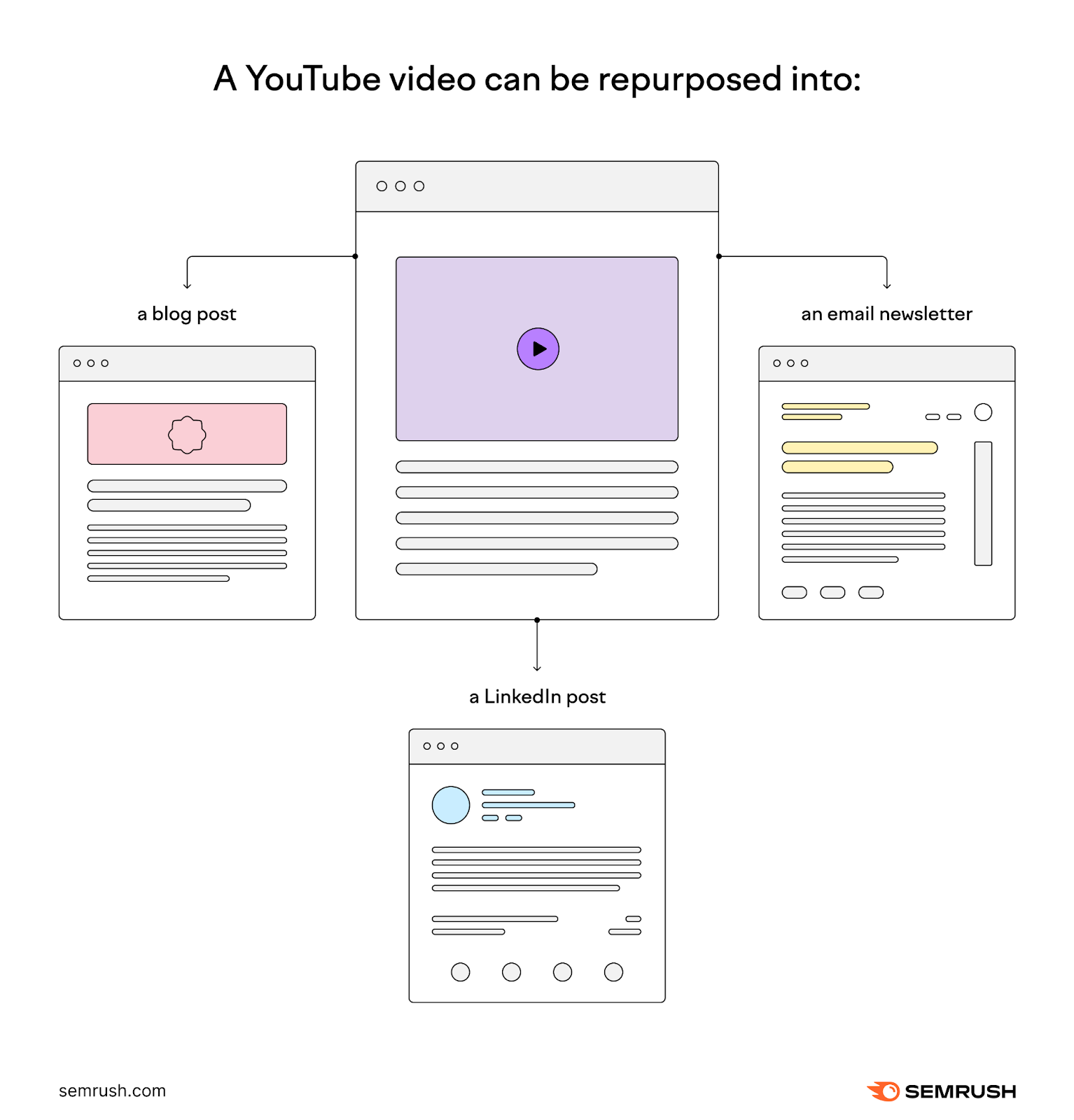
Repurposing content allows you to scale production without creating each piece of content from scratch.
Which lowers marketing costs. And allows you to broaden that content’s reach through wider distribution.
When recycling content, start with your top performers. Since this content is already successful in one form, it will probably perform well in other forms and on other platforms.
Find top-performing content with the Organic Traffic Insights tool.
First, set up a Semrush project. (Here’s a tutorial if you don’t know how.)
Then, configure the tool by connecting your Google Analytics and Google Search Console accounts.
When the configuration is complete, your dashboard will look like this:

Make sure to order the list by “Sessions” to see your top-performing (meaning high-traffic) content at the top.
Then, it’s just a matter of deciding which piece of content to repurpose first.
You can then distribute those different forms of content across different channels.
For example, if you’re repurposing a report into social media infographics, use simple language. It’s more appropriate for social media users who usually want quick insights.
Save more complex ideas for in-depth articles.
6. Measure Your Organic Content’s Success
Analyzing content performance helps you understand what types perform best with your audience, how they discover it, and how they engage with it. So you can refine your content strategy.
One way to measure content success is to track search performance.
Semrush’s Position Tracking tool allows you to do this by monitoring your organic content rankings for select keywords.
Creating a Position Tracking project is easy. Enter your domain in the search bar and click “Set up tracking.”

In the next step, choose your search engine, device type, and location. Then, click “Continue To Keywords.”

Manually enter the keywords you want to track or import them from an external source.
Then, click “Add keywords to campaign” and select “Start Tracking.”

The dashboard displays the domain’s overall visibility for your target keywords. Click on the “Overview” tab to see insights for specific keywords.
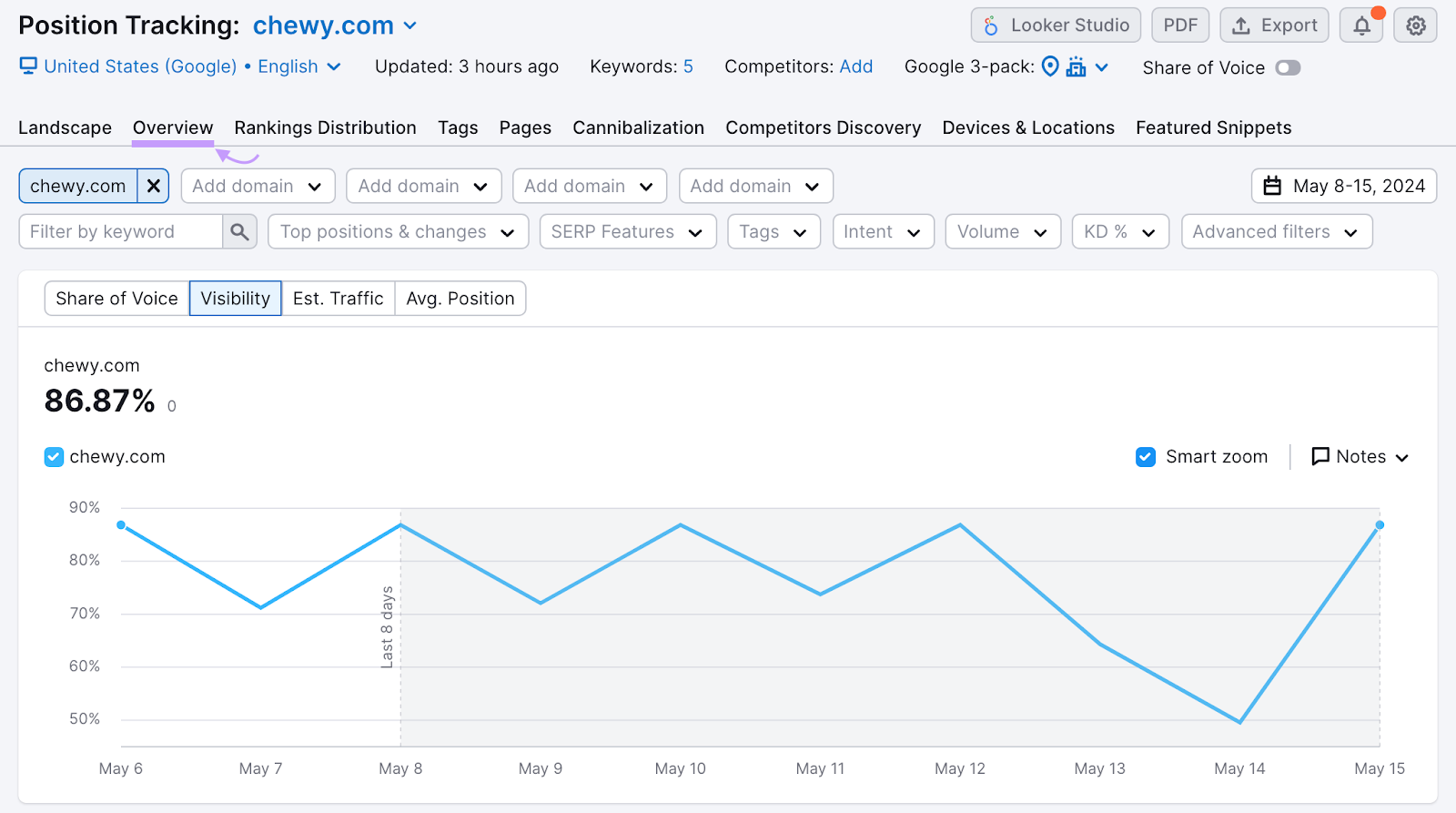
Scroll down to the “Rankings Overview” table to see a detailed overview of any changes in rankings and visibility.

The “Competitors Discovery” tab provides insights into the competition for your target keywords. So you can monitor your competitors’ visibility and compare it to yours.
And proactively investigate and respond to their advances in search rankings.

Create Organic Content That Stands Out
Stand out in a sea of content by doing your research before jumping into production.
That way, you can create quality content and optimize it with the Keyword Magic Tool and SEO Writing Assistant.
And Semrush’s all-in-one platform has even more tools to help. Covering everything from SEO and competitor research to content and social media marketing.
